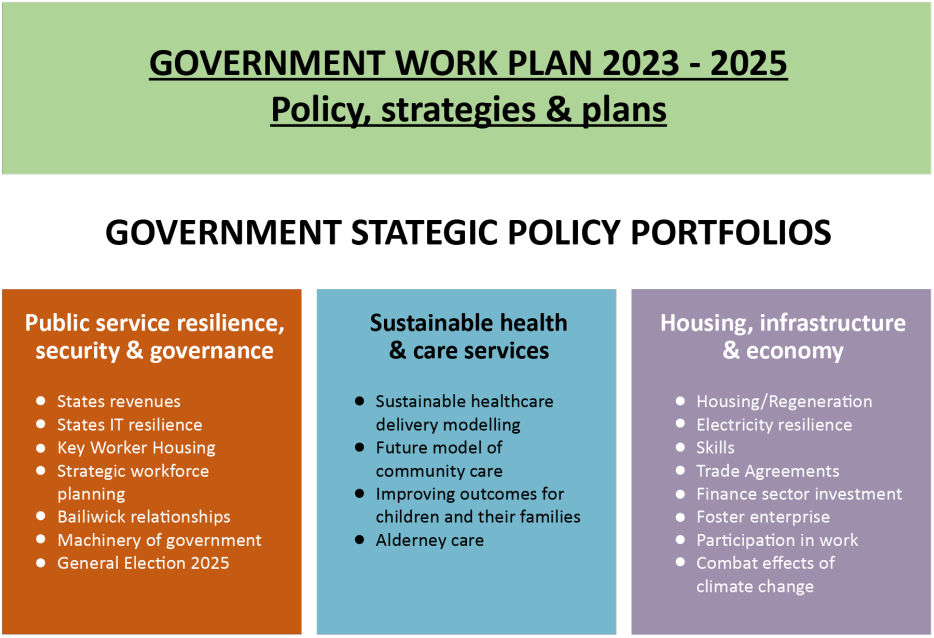
The Government Work Plan 2022-2025: Investing in Islanders, Our Island and Our Future is the States' integrated action plan for this political term.
The Government Work Plan was agreed by the Assembly in July 2021. The corresponding Government Work Plan - Stage 2 Policy Letter is available here.
A further policy letter reviewing and refreshing the GWP was agreed by the Assembly in July 2022 and can be downloaded here.
The latest version of the Government Work Plan takes the form of a ‘mid-term’ reset. A ‘green paper’ debate was held in July to establish the general principles. The policy letter is available here.
Following in-principle support from the Assembly the Government Work Plan will come back in October with formal recommendations for States Members to vote on. These can be seen here.
Monitoring Reports on progress of the Plan are also regularly published and available in the ‘Downloads’ section at the bottom of this page.
About the Government Work Plan 2023 - 2025 'mid-term reset'

The latest Government Work Plan (GWP) comes at a time of major challenges for the Island. Guernsey has felt the impacts of major global events this term – recovering from the COVID pandemic, moving into the post-Brexit period and the on-going war in Ukraine. These challenges combined have led to high inflation rates which have had a material impact on the affordability of basic goods for islanders and for the States.
Alongside these challenges is the rapidly growing demand for services, particularly in areas such as health and care. This is driven by demographic changes with more people living longer and fewer working compounded by a reducing birth rate. As things are, public sector resources will continue to be severely overstretched with the deficit in public finances forecast to grow to £100m per year, every year, in real terms, by 2040. More information on public finances is available at Public finances | States Of Guernsey (ourfuture.gg)
The GWP proposes delivery requirements for the remainder of this political term and forecasts the funding requirements. It addresses both the obligatory work of an independent jurisdiction necessary to meet international trade and compliance regulations and the work to grow a competitive economy by tackling supply and affordability of housing and re-skilling the workforce. In addition, the work considered essential by States Committees to address current and emerging issues has been prioritised.
The availability and affordability of housing
A clear message from the July debate was the criticality of improving the availability and affordability of housing.
Providing and facilitating the development of more housing of all tenures, including key worker housing, is an important part of delivering all three of the portfolios of work. This is reflected in a number of ways in the Government Work Plan, including:
- Recommending funding and resource for phase 1 activity arising from the recently published Guernsey Housing Plan;
- Proceeding with the first phase of implementing the General Housing Law, which in time will become self-financing;
- Setting out a plan for sites to be developed by the Guernsey Housing Association alongside other opportunities for private developers and construction businesses in the medium-to-longer-term; and
- Seeking States Members’ support in principle to invest in the regeneration of the Bridge area for housing and associated flood defence work.
What happens in October?
The Government Work Plan recommendations will be debated in October. These are available in full in the Downloads section on this page. Also, the October States Meeting will see the Assembly debate the Capital Portfolio, which sets out the States’ major infrastructure projects, and the Funding & Investment Plan, which examines the likely cost of delivering public services and government obligations over the next ten years and considers how this can be financed.
The Capital Portfolio and Funding & Investment Plan recommendations will be published in September, but you can find information and background on Public finances | States Of Guernsey (ourfuture.gg).
Useful pages
- Media release - 13th June 2023 - Government Work Plan: ‘Mid-term Reset’ Green Paper
- Media release - 9th June 2023 - Policy & Resources Committee sets out timeline for decision-making on Government Work Plan, Capital Portfolio and Funding & Investment Plan debates
- Media release - 13th May 2022 - Government Work Plan: annual update to be debated in June
- States Resolutions
- New Legislation